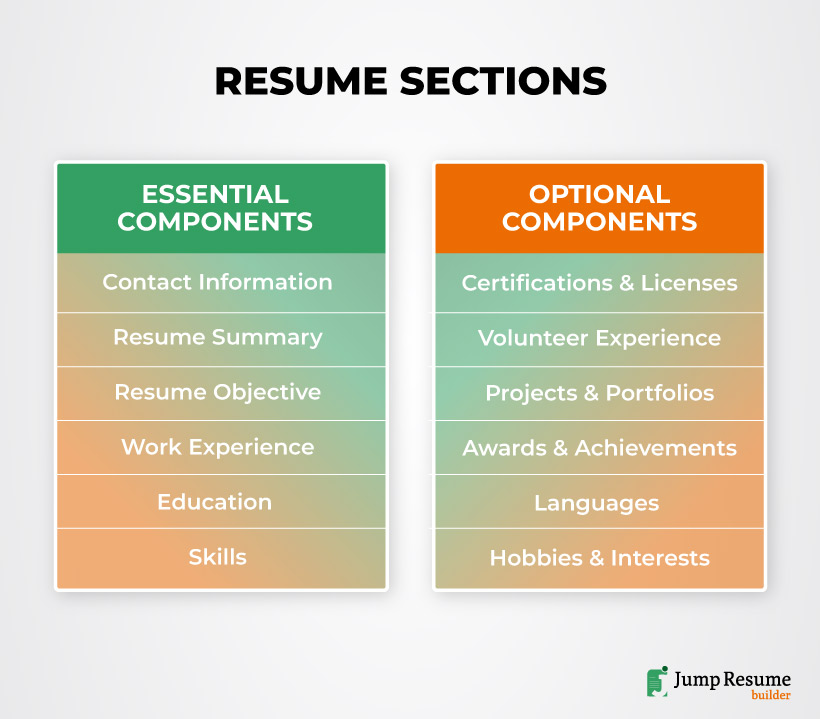A resume is the most crucial tool in your job search. A well-structured resume not only highlights your qualifications but also makes it easier for recruiters to find key details. If your resume lacks proper sections and organization, it may get ignored—even if you have strong experience.
This blog will walk you through the essential and optional resume sections, the best order for different career levels, and how to title each section for maximum impact.
Whether you’re creating a resume from scratch or refining your existing one, these insights will help you build a document that stands out.
Why Do Resume Sections Matter?
Recruiters take only 6-7 seconds to scan a resume before deciding whether to keep reading. If your resume is poorly structured, they might miss key details and move on to another candidate.
A clear and organized resume helps recruiters find important information fast. Here’s why well-defined sections matter:
- Makes Reading Easier – A structured layout helps recruiters scan your resume quickly.
- Works with ATS Systems – Many companies use Applicant Tracking Systems (ATS) that scan resumes for standard section titles.
- Highlights Key Strengths – A good structure ensures your most impressive skills and experience stand out.
Now, let’s go over the must-have and optional resume sections that will make your resume more effective.
Must-Have Resume Sections
Every resume, no matter the industry, needs key sections to be clear, professional, and easy to read. One of the most important is your contact information—without it, recruiters can’t reach you!
Contact Information: The Starting Point
Your contact details should always be at the top of your resume. This makes it easy for hiring managers to find and reach out to you.
What to Include:
- Full Name – Use your professional name, as seen on official documents.
- Phone Number – Double-check that it’s correct and up-to-date.
- Professional Email Address – Use a clean format like firstname.lastname@email.com.
- LinkedIn Profile – Optional but highly recommended, especially for corporate roles.
- Portfolio or Website – Essential for creative, IT, or freelance professionals.
Avoid These Mistakes:
- Unprofessional email addresses – Avoid names like coolguy123@email.com.
- Full home address – City and state are enough; no need for full details.
- Multiple phone numbers – Stick to one reliable number to avoid confusion.
By following these simple but crucial contact section guidelines, you make sure that recruiters can easily get in touch with you. Now, let’s explore the next must-have sections of your resume.
Suggested Reads: How to Write an Effective Resume Summary + Examples
Resume Summary or Objective: Your Elevator Pitch
Your resume summary or objective is a short introduction that sits at the top of your resume. It gives recruiters a quick snapshot of who you are and what you bring to the table.
Should You Use a Summary or an Objective?
- Use a Resume Summary: If you have work experience and want to highlight your key achievements.
- Use a Resume Objective: If you’re a recent graduate or career changer and need to explain your goals.
Examples:
Resume Summary (For an IT Professional):
“Results-driven software developer with 5+ years of experience in Python and cloud computing. Skilled in optimizing system performance and implementing scalable solutions to drive business growth.”
Resume Objective (For an Entry-Level Marketer):
“Creative marketing graduate eager to apply social media and content marketing skills in a fast-paced agency environment.”
A well-written summary or objective instantly grabs attention and helps recruiters understand your value. Now, let’s move on to the work experience section—the most important part of your resume!
Work Experience: The Core of Your Resume
Your work experience is the most important section of your resume. Employers want to see what you’ve accomplished in past roles.
How to Structure Your Work Experience:
- Job Title – Company Name – Location – Employment Dates
- Key Responsibilities & Achievements (Bullet points preferred)
- Use Action Verbs (e.g., “Developed,” “Led,” “Implemented”)
- Quantify Achievements (e.g., “Increased sales by 20%”)
Example (Sales Manager Role):
Sales Manager | ABC Corporation | New York, NY | 2018–Present
- Managed a team of 10 sales associates, increasing revenue by 30% in one year.
- Developed and implemented a new client retention strategy, reducing churn by 15%.
- Trained new hires, improving onboarding efficiency by 25%.
Mistakes to Avoid:
- Using vague descriptions like “Responsible for sales” instead of “Led a sales team that increased revenue by 30%”.
- Listing duties without achievements.
Education Section: Showcasing Academic Credentials
Your education section tells recruiters about your academic background. Where you place it on your resume depends on your experience level:
- Recent Graduates – List your education before work experience since it’s your strongest qualification.
- Experienced Professionals – Place education after work experience to keep the focus on your career achievements.
What to Include:
- Degree Earned – (e.g., B.A., B.S., MBA).
- Institution Name – The name of the university or college.
- Graduation Year – Optional if you have 10+ years of experience.
- GPA – Only include if it’s above 3.5 and you’re a recent graduate.
What to Leave Out:
- High school education – Skip this if you have a college degree.
- Unrelated coursework – Only list courses relevant to the job.
A well-structured education section makes it easy for employers to see your qualifications at a glance.
Skills Section: Proving Your Capabilities
Your skills section shows employers what you can do. To make it effective, focus on job-relevant abilities that match the job description.
How to List Skills Effectively:
- Separate Hard and Soft Skills – Hard skills include technical abilities, software, and languages, while soft skills cover communication, leadership, and teamwork.
- Use Proficiency Levels – If needed, indicate skill levels (e.g., Beginner, Intermediate, Advanced).
- Keep It Relevant – List skills that apply to the job you’re applying for.
Example (For a Digital Marketer):
- SEO & SEM
- Google Analytics & AdWords
- Email Marketing
- Content Strategy
What to Avoid:
Generic Soft Skills – Instead of saying “Good communicator”, write “Presented marketing insights to stakeholders, increasing campaign approval rate by 40%.”
A strong skills section shows employers your strengths at a glance. In the optional resume sections, we will focus on what can make your application stand out.
Read More: Resume Layout: Examples and Best How-To Tips

Optional Resume Sections: Enhance Your Profile
Adding optional sections to your resume can help you stand out, especially if they highlight unique skills or achievements. Choose the ones that best fit your career path.
Certifications & Licenses
If you have industry-recognized certifications, list them to showcase specialized skills. These are especially valuable in IT, project management, and healthcare.
Examples:
- PMP (Project Management Professional)
- AWS Certified Solutions Architect
- Google Analytics Certification
Volunteer Experience
If your volunteer work relates to the job, format it like a job entry to highlight transferable skills.
Example:
“Organized a fundraising campaign that raised $10,000 for local charities, leading a team of five volunteers.”
Projects & Portfolios
If you work in IT, design, or creative industries, including a project or portfolio section can demonstrate real-world skills.
What to Include:
- Briefly describe the project and its impact.
- Provide links to work samples or GitHub repositories.
Awards & Achievements
Showcase recognitions, competitions, or professional milestones.
Example:
“Recognized as Top Sales Representative (2022) for exceeding sales quota by 50%.”
Languages
If language skills are relevant to the job, list proficiency levels clearly.
Example:
- Fluent in Spanish
- Intermediate in French
Hobbies & Interests
Include hobbies only if they add value to your application.
Example:
“Passionate about public speaking—regular TEDx speaker.”
A well-structured resume with strategic optional sections can make a lasting impression. Next, we’ll explore how to arrange resume sections for maximum impact.
Resume Order: What Goes Where?
The order of your resume sections plays a key role in how recruiters view your qualifications. If sections are misplaced or poorly structured, hiring managers may miss important details, lowering your chances of getting an interview.
To make a strong impression, follow the best resume order based on your experience level.
For Experienced Professionals:
If you have several years of experience, recruiters will focus on your work history first. Your resume should showcase career achievements before education or certifications.
Recommended Section Order:
- Resume Summary
- Work Experience
- Skills
- Education
- Certifications (if applicable)
Why This Order Works:
- Work experience is the primary focus, demonstrating career growth.
- Skills and certifications reinforce expertise in the industry.
- The summary provides a quick snapshot of professional value.
For Recent Graduates:
If you recently graduated or have limited work experience, your education and skills should come first to highlight your qualifications.
Recommended Section Order:
- Education
- Skills
- Work Experience (Internships, Part-time Jobs)
- Certifications
Why This Order Works:
- Education is highlighted, making up for limited experience.
- Skills and certifications prove industry readiness.
- Internships and part-time jobs show hands-on experience.
Pro Tips: When to Adjust the Order
- If you have strong work experience, move Work Experience above Education.
- For career changers, emphasize transferable skills by placing Skills before Work Experience.
- For technical roles, place Skills directly after Summary to highlight expertise early.
A well-structured resume ensures that recruiters see the most important details first.
Resume Section Titles
The section titles on your resume should be clear and easy to understand. While standard titles work well, adding a creative touch can help your resume stand out—as long as it remains professional.
Creative Resume Section Titles
If you want to make your resume more engaging, consider these alternatives:
- Work Experience → Career Highlights
- Skills → Technical Proficiency & Tools
- Education → Academic Credentials
These variations can make your resume more dynamic and industry-specific, helping recruiters quickly understand your qualifications.
Avoid Overcomplicated Titles
While creativity is good, overly vague or informal section titles can confuse recruiters. Avoid titles that lack clarity or professionalism, such as:
- “My Journey in the Corporate World” – Too vague; it doesn’t clearly define work experience.
- “Things I’m Great At” – Unprofessional; use “Skills” or “Core Competencies” instead.
- “The Knowledge I Gained” – Unclear; “Education” or “Academic Background” is more precise.
A well-structured resume with clear and engaging section titles makes it easier to read while leaving a strong first impression.
Also Read: 25 Best Skills to Put on a Resume
Common Mistakes to Avoid in Resume Structuring
A poorly structured resume can hurt your chances of landing an interview. Here are common mistakes to avoid:
- Cluttering the Resume: Keep it 1-2 pages max.
- Misplacing Key Sections: Work experience should always be easy to find.
- Using Poor Formatting: Stick to consistent fonts, bullet points, and spacing.
Final Thoughts
Your resume is more than a list of jobs and skills. It is a marketing tool that shows employers why you are the right fit. A well-structured, ATS-friendly resume improves your chances of getting noticed and landing interviews.
By following these best practices, you will create a resume that is clear, compelling, and tailored to your career goals.
But why spend hours formatting and optimizing your resume when you can build a professional one in minutes?
Try Jump Resume Builder—The Smart Way to Get Hired!
Jump Resume Builder makes resume creation simple and stress-free. Our AI-powered, user-friendly platform helps you create a resume that is:
- Professionally formatted to grab attention.
- Optimized for ATS compatibility so it never gets lost in the system.
- Tailored to your industry to help you stand out in a competitive job market.
Take control of your job search with a resume that gets results.
- Get started with Jump Resume Builder today and create your resume without any hassle!
- Have questions or need support? Contact us here. Our team is ready to help you build a resume that gets interviews.




